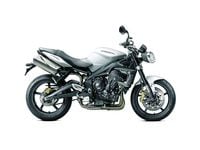Got A Question For Answers? Send It To mcmail@sorc.com
**No Bearing **
I've got a 2008 Harley-Davidson Electra Glide. I had two input-shaft bearing/race failures in 40,000 miles: the first at 28,000 miles and the second 10,000 miles later. I've read on the forums that this is a very common issue, but the folks at the dealer say they seldom see this. Do you have any information on why they would be covering it up?
Bob Perry
Vacaville, CA
_Don’t believe everything you read on the Internet. According to renowned H-D technical expert Kip Woodring, author of 101 Harley-Davidson Evolution Performance Projects, it all started with everybody wanting a six-speed. “In this case—pun intended—it’s because Harley used helical gears which side-load the bearing,” Woodring says. Hence the early, wary behavior regarding 15,000-mile bearing replacement when this transmission first appeared on ’06 Dyna models. The Motor Company rescinded that offer within months, mostly because of the lack of service problems in the field.
“That’s all well and good for bone-stock, 650-lb., 88-inch Dynas, but heavier, torquier Big Twin models—all of them since then—keep crowding the limits of the existing setup,” Woodring continues. “Especially the more potent 103-inch and bigger twins. There have been at least two updates: first in ’07 to the inner bearing race. The second in 2010 was major: a reverse-helical fifth gear to effectively neutralize side loads on the bearing. That fifth-gear update is available as a kit from your local dealer for owners of early models who fear they may have a problem. It has as much or more to do with the race on the shaft than the bearing itself. It’s not unheard of for this race to move, which lets the seal leak and the bearing walk/wobble more than intended, accelerating wear and possible failure.” Two failures in 40,000 miles tell us you’re either wildly unlucky, ride harder than most people, or both. Woodring says only a few hard-ridden Big Twins are prone to actual bearing failure. Seen through the lens of Internet exaggeration, they make a small problem look bigger than it really is. _
Electric Range
I’m looking for an electric motorcycle to commute and run errands on, but I need to know how far these things will go on a charge. Where can I find comparable range numbers?
It’s not easy…yet. Different manufacturers compute range figures differently, which is why the Motorcycle Industry Council developed its Urban All-Electric Range Test. Based on a California standard used to satisfy the federal government, it tells you how far a given electric bike goes on a full charge in real-world riding conditions. The basic test cycle uses a top speed of 55.6 mph and a 19.6-mph average. For bikes that aren’t that fast, the low-speed test cycle sets a 36.5-mph maximum and a 17.7-mph average. Zero Motorcycles already uses the MIC testing protocol and lists range numbers as part of its specs. Hopefully, other electric bike brands will do the same soon.
Power & Weight
I was reading back issues of _Motorcyclist _when I saw something that was hard to believe. In your First Ride of the 2009 Triumph Street Triple R by Roland Brown (December 2008), you state, "At 368 lbs., the R's dry-weight figure matches that of the standard model," which is listed in the specs as claimed dry weight. In that same article, Brown says, "Upgraded suspension and brakes mean I'd taken bends quicker than on the standard Street Triple. This bike uses the same 107-horsepower engine, so it's no faster in a straight line, but no worries." That figure is also listed in the specs as a claimed 107 bhp. In the "1-2-3-4" article (April 2008), the standard Triumph Street Triple specs list dry weight as 388 lbs. and horsepower as 91.3. That's up 20 lbs. and down 15 bhp. In a recent issue of another magazine, the 2011 Triumph Street Triple R specs say that dry weight is 410 lbs. and peak horsepower is 92.8. How in the world did the Street Triple R gain 42 lbs. and drop 15 bhp in two years?
Ruben Frye
Houma, LA
_Because it’s impossible to generate our own weight and horsepower numbers at the manufacturer-hosted press intros from which most First Rides derive, we have to rely on the manufacturer-supplied claims. Thus the numbers listed in Roland Brown's First Ride are Triumph factory figures; a detail accidentally omitted from the text. In the “1-2-3-4” article, that dry-weight figure is the actual weight of the bike on our scales with an empty gas tank. Further confusing matters is the fact that many manufacturers have begun listing “curb” weight, which is what used to be called “wet” weight, or what our specs list as “tank full.”
As for engine output, our in-house SuperFlow dyno measures horsepower at the rear wheel—not at the crankshaft as most manufacturers do. We’re sorry to break it to you like this, but our recent, and as yet unpublished, testing reveals that the 2012 Street Triple R weighs 422 lbs. with all fluids on board, including gasoline, and makes 92.3 bhp at the rear wheel. We hope that clears up the weights and measures conundrum once and for all._














/cloudfront-us-east-1.images.arcpublishing.com/octane/FZXHNOQRNVA3BIDWAF46TSX6I4.jpg)
/cloudfront-us-east-1.images.arcpublishing.com/octane/JRSFLB2645FVNOQAZCKC5LNJY4.jpg)
/cloudfront-us-east-1.images.arcpublishing.com/octane/ITNLTIU5QZARHO733XP4EBTNVE.jpg)
/cloudfront-us-east-1.images.arcpublishing.com/octane/VZZXJQ6U3FESFPZCBVXKFSUG4A.jpg)
/cloudfront-us-east-1.images.arcpublishing.com/octane/QCZEPHQAMRHZPLHTDJBIJVWL3M.jpg)
/cloudfront-us-east-1.images.arcpublishing.com/octane/HXOUJXQWA5HBHGRO3EMJIGFMVI.jpg)

/cloudfront-us-east-1.images.arcpublishing.com/octane/3TIWWRV4JBBOLDVGRYECVVTA7Y.jpg)
/cloudfront-us-east-1.images.arcpublishing.com/octane/KIX5O23D5NAIBGFXBN3327DKZU.jpg)
/cloudfront-us-east-1.images.arcpublishing.com/octane/7GJYDUIPXRGMTMQKN6ONYOLBOU.jpg)
/cloudfront-us-east-1.images.arcpublishing.com/octane/MUQLOVLL2ZDGFH25ILABNBXKTI.jpg)
/cloudfront-us-east-1.images.arcpublishing.com/octane/TNOU5DNE2BC57MFPMGN2EIDXAM.jpg)
/cloudfront-us-east-1.images.arcpublishing.com/octane/GTCXACQGJ5HAPDTGWUQKDEH44E.jpg)
/cloudfront-us-east-1.images.arcpublishing.com/octane/S35YGSEMEZB4BLTDJTSZPF4GLA.jpg)
/cloudfront-us-east-1.images.arcpublishing.com/octane/5UOT6HPX2JFMRJAX6EH45AR4MQ.jpg)
/cloudfront-us-east-1.images.arcpublishing.com/octane/OKWOJWAKP5EP3OACCRRWPCIX2Q.jpg)
/cloudfront-us-east-1.images.arcpublishing.com/octane/2WF3SCE3NFBQXLDNJM7KMXA45E.jpg)
/cloudfront-us-east-1.images.arcpublishing.com/octane/G4MG6OUCJNBSHIS2MVVOTPX65E.jpg)
/cloudfront-us-east-1.images.arcpublishing.com/octane/IIGGWFOTOJGB7DB6DGBXCCMTDY.jpg)
/cloudfront-us-east-1.images.arcpublishing.com/octane/QSTCM6AVEZA5JJBUXNIQ3DSOF4.jpg)
/cloudfront-us-east-1.images.arcpublishing.com/octane/U4I7G625B5DMLF2DVIJDFZVV6M.jpg)
/cloudfront-us-east-1.images.arcpublishing.com/octane/B6XD6LS6IVCQPIU6HXDJSM3FHY.jpg)
/cloudfront-us-east-1.images.arcpublishing.com/octane/ICL63FEDDRDTTMINYICCEYGMDA.jpg)
/cloudfront-us-east-1.images.arcpublishing.com/octane/FCGZHQXRBZFLBAPC5SDIQLVF4I.jpg)